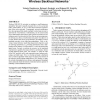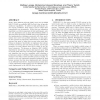23589 search results - page 4633 / 4718 » Uncheatable Distributed Computations |
MOBICOM
2004
ACM
15 years 3 months ago
2004
ACM
Wireless IEEE 802.11 networks in residences, small businesses, and public “hot spots” typically encounter the wireline access link (DSL, cable modem, T1, etc.) as the slowest ...
MOBICOM
2004
ACM
15 years 3 months ago
2004
ACM
—The traffic load of wireless LANs is often unevenly distributed among the access points (APs), which results in unfair bandwidth allocation among users. We argue that the load ...
104
click to vote
MOBICOM
2004
ACM
15 years 3 months ago
2004
ACM
The IEEE 802.11 wireless LAN standard power-saving mode (PSM) allows the network interface card (NIC) to periodically sleep between receiving data. In this paper, we show that 802...
110
click to vote
MOBIHOC
2004
ACM
15 years 3 months ago
2004
ACM
Mobile Ad Hoc Networks (MANETs) provide rapidly deployable and self-configuring network capacity required in many critical applications, e.g., battlefields, disaster relief and ...
MSWIM
2004
ACM
15 years 3 months ago
2004
ACM
Today, three different physical (PHY) layers for the IEEE 802.11 WLAN are available (802.11a/b/g); they all provide multi-rate capabilities. To achieve a high performance under v...


